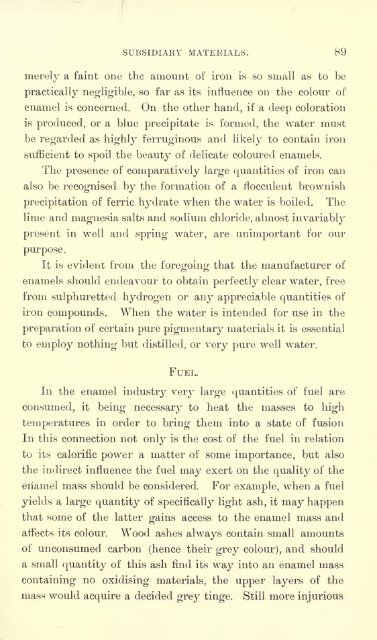Enamels and enamelling; an introduction to the preparation and ...
Enamels and enamelling; an introduction to the preparation and ...
Enamels and enamelling; an introduction to the preparation and ...
You also want an ePaper? Increase the reach of your titles
YUMPU automatically turns print PDFs into web optimized ePapers that Google loves.
merely<br />
SUBSIDIARY MATERIALS. 89<br />
a faint one <strong>the</strong> amount of iron is so small as <strong>to</strong> be<br />
practically negligible, so far as its influence on <strong>the</strong> colour of<br />
enamel is concerned. On <strong>the</strong> o<strong>the</strong>r h<strong><strong>an</strong>d</strong>, if a deep coloration<br />
is produced, or a blue precipitate is formed, <strong>the</strong> water must<br />
be regarded as highly ferruginous <strong><strong>an</strong>d</strong> likely <strong>to</strong> contain iron<br />
sufficient <strong>to</strong> spoil <strong>the</strong> beauty of delicate coloured enamels.<br />
The presence of comparatively large qu<strong>an</strong>tities of iron c<strong>an</strong><br />
also be recognised by <strong>the</strong> formation of a flocculent brownish<br />
precipitation of ferric hydrate when <strong>the</strong> water is boiled. The<br />
lime <strong><strong>an</strong>d</strong> magnesia salts <strong><strong>an</strong>d</strong> sodium chloride, almost invariably<br />
present in well <strong><strong>an</strong>d</strong> spring water, are unimport<strong>an</strong>t for our<br />
purpose.<br />
It is evident from <strong>the</strong> foregoing that <strong>the</strong> m<strong>an</strong>ufacturer of<br />
enamels should endeavour <strong>to</strong> obtain perfectly clear water, free<br />
from sulphuretted hydrogen or <strong>an</strong>y appreciable qu<strong>an</strong>tities of<br />
iron compounds. When <strong>the</strong> water is intended for use in <strong>the</strong><br />
materials it is essential<br />
<strong>preparation</strong> of certain pure pigmentary<br />
<strong>to</strong> employ nothing but distilled, or very pure well water.<br />
FUEL.<br />
In <strong>the</strong> enamel industry very large qu<strong>an</strong>tities of fuel are<br />
consumed, it being necessary <strong>to</strong> heat <strong>the</strong> masses <strong>to</strong> high<br />
temperatures in order <strong>to</strong> bring <strong>the</strong>m in<strong>to</strong> a state of fusion<br />
In this connection not only is <strong>the</strong> cost of <strong>the</strong> fuel in relation<br />
<strong>to</strong> its calorific power a matter of some import<strong>an</strong>ce, but also<br />
<strong>the</strong> indirect influence <strong>the</strong> fuel may exert on <strong>the</strong> quality of <strong>the</strong><br />
eiiamel mass should be considered. For example, when a fuel<br />
yields a large qu<strong>an</strong>tity of specifically light ash, it may happen<br />
that some of <strong>the</strong> latter gains access <strong>to</strong> <strong>the</strong> enamel mass <strong><strong>an</strong>d</strong><br />
affects its colour. Wood ashes always contain small amounts<br />
of unconsumed carbon (hence <strong>the</strong>ir grey colour), <strong><strong>an</strong>d</strong> should<br />
a small qu<strong>an</strong>tity of this ash find its way in<strong>to</strong> <strong>an</strong> enamel mass<br />
containing no oxidising materials, <strong>the</strong> upper layers of <strong>the</strong><br />
mass would acquire a decided grey tinge. Still more injurious
















